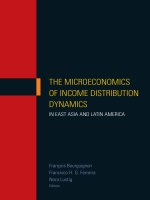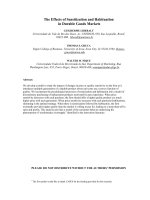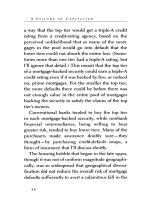The application of islamic criminal law in pakistan
Bạn đang xem bản rút gọn của tài liệu. Xem và tải ngay bản đầy đủ của tài liệu tại đây (1.42 MB, 429 trang )
The Application of Islamic Criminal Law
in Pakistan
Brill’s Arab and
Islamic Laws Series
Editorial Board
H.H. Prof. Eugene Cotran
Mark Hoyle
Martin Lau
VOLUME 2
The Application of Islamic
Criminal Law in Pakistan
Sharia in Practice
By
Tahir Wasti
LEIDEN • BOSTON
2009
This book is printed on acid-free paper.
Library of Congress Cataloging-in-Publication Data
Wasti, Tahir.
The application of Islamic criminal law in Pakistan : Sharia in practice / by Tahir
Wasti.
p. cm. — (Brill’s Arab and Islamic laws series ; v. 2)
Includes bibliographical references and index.
ISBN 978-90-04-17225-8 (hardback : alk. paper)
1. Reparation (Criminal justice)—Pakistan. 2. Criminal justice, Administration
of—Pakistan. 3. Reparation (Islamic law)—Pakistan. 4. Punishment (Islamic law)—
Pakistan. 5. Blood money (Islamic law)—Pakistan. 6. Criminal justice, Administration
of (Islamic law)—Pakistan. 7. Islamic law—Pakistan. I. Title. II. Series.
KPL3952.W37 2009
345.5491’05—dc22
2008040108
ISSN 1871-2894
ISBN 978 90 04 17225 8
Copyright 2009 by Koninklijke Brill NV, Leiden, The Netherlands.
Koninklijke Brill NV incorporates the imprints Brill, Hotei Publishing,
IDC Publishers, Martinus Nijhoff Publishers and VSP.
All rights reserved. No part of this publication may be reproduced, translated,
stored in a retrieval system, or transmitted in any form or by any means, electronic,
mechanical, photocopying, recording or otherwise, without prior written permission
from the publisher.
Authorization to photocopy items for internal or personal use is granted by
Koninklijke Brill NV provided that the appropriate fees are paid directly to
The Copyright Clearance Center, 222 Rosewood Drive, Suite 910,
Danvers, MA 01923, USA.
Fees are subject to change.
printed in the netherlands
To Fatima and Zainab
CONTENTS
List of Tables ......................................................................................
List of Graphs .....................................................................................
Acknowledgements ............................................................................
List of Abbreviations .........................................................................
Glossary ...............................................................................................
ix
xi
xiii
xv
xvii
Introduction Islamic Law in Practice: The Application of
Qisas and Diyat Law in Pakistan ................................................
1
Chapter One
The Study .................................................................
17
Chapter Two Legal and Theoretical Foundation of the
Qisas and Diyat Law in Pakistan ................................................
57
Chapter Three The Evolution of the Qisas and Diyat Law in
Pakistan: A Brief History .............................................................
99
Chapter Four Assembly Debates on the Law of Murder and
Homicide, 1981–97 .......................................................................
143
Chapter Five
The New Law and Judiciary .................................
165
Chapter Six Impact of Qisas and Diyat Law on the
Administration of Criminal Justice in Pakistan .......................
239
Chapter Seven
Conclusion ............................................................
283
Appendix A: Chronology of Events ...............................................
Appendix B: Draft Ordinance .........................................................
Appendix C: The Ordinance 1990 ..................................................
Appendix D: The Act of 1997 .........................................................
Appendix E: Tables of the Ten District’s Police Records ...........
Appendix F: Tables of the Ten Districts’ Session Courts
Records ............................................................................................
Appendix G: Homicide Rate of Pakistan ......................................
289
299
315
328
354
365
376
viii
contents
Appendix H: Questionnaire .............................................................
Appendix I: List of Cases .................................................................
Appendix J: List of Statutes .............................................................
378
380
385
Bibliography ........................................................................................
387
Index ....................................................................................................
403
LIST OF TABLES
Table 6.1 Accumulative Data of Ten Districts of the Sample
Area Derived from the Police Records ......................................
Table 6.2 Accumulative Data of the Sample Area Derived
from the Sessions Courts Records ..............................................
Table 6.3 Multan High Court: Murder References Decided
by the Multan High Court, 1981–2000 .....................................
Table 6.4 Criminal Appeals Decided by the Supreme Court
of Pakistan, 1981–2000 .................................................................
Table E.1 District Multan Police Records ..................................
Table E.2 District Khanewal Police Records ..............................
Table E.3 District Vehari Police Records ...................................
Table E.4 District Sahiwal Police Records ..................................
Table E.5 District Pakpattan Police Records ..............................
Table E.6 District Lodhran Police Records ................................
Table E.7 District DG Khan Police Records ..............................
Table E.8 District Rajanpur Police Records ...............................
Table E.9 District Layyah Police Records ...................................
Table E.10 District Muzaffargargh Police Records .....................
Table F.1 Sessions Courts Multan ...............................................
Table F.2 Sessions Courts Khanewal ...........................................
Table F.3 Sessions Courts Vehari ................................................
Table F.4 Sessions Courts Sahiwal ...............................................
Table F.5 Sessions Courts Pakpattan ...........................................
Table F.6 Sessions Courts Lodhran .............................................
Table F.7 Sessions Courts DG Khan ...........................................
Table F.8 Sessions Courts Rajanpur ............................................
Table F.9 District Layyah ..............................................................
Table F.10 Sessions Courts District Muzaffargargh ....................
Table G.1 Homicide Rate in Pakistan ..........................................
Table G.2 Average Homicide Rate per 100,000 Population
in Two Decades .............................................................................
258
262
270
274
354
356
357
358
359
360
361
362
363
364
365
367
368
369
370
371
372
373
374
375
376
376
LIST OF GRAPHS
Graph 6.1 Homicide Rate per 100,000 Population
(Sample Area) .................................................................................
Graph 6.2 Conviction Rate from Police Records
(Sample Area) .................................................................................
Graph 6.3 Percentage of Cases Undecided and Cancelled by
Ten Districts’ Police Records .......................................................
Graph 6.4 Conviction Rate from Sessions Courts Records
(Sample Area) .................................................................................
Graph 6.5 Rate of Death Sentences from Sessions Courts
Records ............................................................................................
Graph 6.6 Rate of Life Sentences from Sessions Courts
Records ............................................................................................
Graph 6.7 Rate of Compromise from District Attorney’s
Office ...............................................................................................
Graph 6.8 Rate of Acquittals on Merits from Sessions Courts
Records ............................................................................................
Graph 6.9 Rate of Total Acquittals from Sessions Courts
Records ............................................................................................
Graph 6.10 Rate of Conviction, Multan Bench of Lahor High
Court, 1981–2000 ..........................................................................
Graph 6.11 Rate of Conviction, Supreme Court of Pakistan,
1981–2000 .......................................................................................
Graph 6.12 Rate of Acquittal, Supreme Court of Pakistan,
1981–2000 .......................................................................................
Graph 6.13 Homicide Rates in Pakistan since 1981 .................
259
260
261
264
264
265
265
266
266
271
275
275
377
ACKNOWLEDGEMENTS
My foremost and heartfelt thanks go to my doctoral supervisor, Dr
Martin Lau, Barrister-at-Law. I feel fortunate to have been able to work
with him. His scholarly rigour and deep insight into Pakistani law
inspired and sustained me throughout this research, which would not
have been possible without his support. Thanks are also due to Dr Lyn
Welchman of the SOAS Law Department, whose incisive comments and
constructive advice in the initial period of this study were immensely
helpful. I have been particularly fortunate to discuss parts of this work
with my friend Dr Sarah Amsler, who not only helped to edit the book
but also engaged in stimulating conversations about its content.
I was very privileged to have the encouragement of a wide network of
friends from Pakistan. I am grateful to them all, in particular to Justice
Mian Mohammad Zafar Yasin, Justice Jawad S. Khawaja, Justice M.A.
Shahid Siddiqui, Justice Khalil-ur-Rahman Ramday and others, whose
understanding and support enabled me to pursue this research.
I am grateful to all of the interviewees—lawyers, members of the
judiciary, clerks of courts, litigants and their families—for their patient
co-operation and frankness in answering my questions. Special thanks
go to the late Barrister Ejaz Hussain Batalvi, who despite illness and
an extremely busy schedule, granted three long interviews. Being a
prominent criminal lawyer, the chief prosecutor of Bhutto’s murder
case and a close associate of both Bhutto and Zia-ul-Haq, he provided
me with a first-hand account of the process of Islamisation initiated by
General Zia. Thanks are also due to Ali Naqi Naqvi, Solicitor General
of Punjab, for his relentless efforts in persuading district attorneys to
provide me with requisite data from their offices.
I am indebted to the registrars of The Supreme Court of Pakistan,
The Federal Shariat court of Pakistan, The Lahore High Court, and
the Additional Registrar of the Lahore High Court, Multan Bench,
for allowing me access to records of cases and answering my various queries. Thanks also to the Superintendents of the district police
offices, the Sessions Courts and the prisons that I visited, who not
only tolerated my presence in their offices but also provided me with
insights into various case files and divulged the processes of gathering
and recording data.
xiv
acknowledgements
I am grateful for the cooperation and assistance of the staff of libraries at the National Assembly Pakistan, Council of Islamic Ideology, the
Federal Ministry of Law and Parliamentary Affairs, India Office Library,
SOAS, LSE, Institute of Advanced Legal Studies, Bodleian Law Library
at the University of Oxford and the Squire Law Library, University of
Cambridge.
I must thank all my family for supporting me in moments of vacillation. My sister Abida was always there for me on the other end of
the telephone line, to say, “Bhai jan, you can do it”. Many thanks to
my brothers: Shamim H. Zaidi Advocate for his general support and
thorough proofreading, and Ali Ghalib, for providing handy help with
computers and formatting.
A special thanks goes out to Professor M. Saeed Bahmanpour, Director
Islamic College for Advanced Studies, London, for his comments on the
draft of Chapter Two as well as his empathy over the last few years. I
am extremely grateful to Dr Ghalib K. Lodhi, Kazim Mehdevy and Dr
Mohammad Ahsan for their insightful feedback on many of the ideas
in the initial stages of this project and their warm companionship.
Thanks are also due to Ms Ingrid Heijckers and Mrs Marleen
Schouten- Vink, who proved to be efficient, wise and patient editors. I
am also grateful to Brill Academic Publishers for publishing this research
in its Brill’s Arab and Islamic Laws Series.
Last but not least, my wife Aaleen deserves many warm thanks. She
not only stood by me throughout the hard times of this marathon
task, but also neatly organised all the material pertaining to this study.
She has consistently read all my drafts and advised me sincerely and
objectively. As a result, she has now become more of a lawyer than an
architect! This book would also be incomplete without mentioning my
two lovely daughters, Fatima and Zainab, whose smiles always worked
as a pain reliever and inspired me to complete the work. I dedicate this
research to them.
LIST OF ABBREVIATIONS
AIR
ALQ
BSOAS
CII
CMLA
Cr or Crl
CrPC
CS
FC
FIR
FSC
IPC
J
Kr
Lah
LC
MLD
MOL
NCSW
NLR
PCrLJ
Pesh
PLD
PLJ
PO
PPC
Q
SC
SCMR
SD
YLR
All India Reporter
Arab Law Quarterly
Bulletin of the School of Oriental and African Studies
Council of Islamic Ideology
Chief Martial Law Administrator
Criminal
Code of Criminal Procedure
Central Statues
Federal Council (Majlis-e-Shoora)
First Information Report
Federal Shariat Court
Indian Penal Code
Journal
Karachi
Lahore
Law Commission
Monthly Law Digest
Ministry of Law
National Commission on the Status of Women
National Law Reporter
Pakistan Criminal Law Journal
Peshawar
[All] Pakistan Legal Decision
Pakistan Law Journal
President’s Order
Pakistan Penal Code
Quetta
Supreme Court
Supreme Court Monthly Review
Shariat Decision
Yearly Law Reports
GLOSSARY
adl
Justice; good character; qualification of character and
piety for appearing as a witness in the court of law
and the principal criterion for judicial appointment
ahkam
rules; judgments; plural of hukm
alim (pl. ulamah) an Islamic religious scholar
amd
intentional or deliberate
amir al-muminin ‘commander of the faithful’; standard title of the
caliph
aqilah
nearest parental kin to an offender (also family and
associates)
arz
land, but also used to indicate a piece of land such
as a State or country
asbah
male residuaries or agnates
afw
Pardon
badl-i-sulh
consideration for compromise or settlement
baitul mal
Public Exchequer—an Islamic treasury set up for
the benefit of Muslims and the Islamic State
bulugh
age of puberty or majority
dhimmis
non-Muslims who are protected by a treaty of surrender
diyat
compensation; blood-money for bodily injuries or
death
fasad
corruption; decay; evil
fasad
to spoil, vitiate, ruin, demoralize, foil, frustrate,
negate, deteriorate, invalidate, purify or decompose
fasad-fil-arz
corruption on earth
fatwa
an advisory opinion by a qualified scholar on a
point of law; plural fatawa
fiqh
Islamic jurisprudence
gharib
strange, weakly attested hadith
hadd
limit or boundary; punishment for offences for
which limits have been defined in the Quran and
Sunnah
hadith
a narrative record of the prophet Muhammad’s
sayings and deeds
xviii
hakim
haq al-allah
haq al-ibad
haraba
ijma
glossary
Arbitrator
rights of God
rights of individuals
hadd crime of brigandage
consensus; agreement of scholars of age; one of four
ususl al-fiqh
ijtihad
to exercise personal judgment based on the Quran
and the Sunnah
ijtihadi
striving; individual research for a ruling from God’s
law or to govern a human action in conditions where
the divine law is definitely not revealed
ikrah
duress; coercion
ikrah-i-naqis
any form of duress which did not amount to ikrahi-tam (section 299(h) PPC)
ikrah-i-taam
putting any person, his spouse or any of his blood
relations within the prohibited degree of marriage in
fear of instant death, instant permanent impairing
of any organ of the body, or instant fear of being
subjected to sodomy or zina-bil-jabr (section 299(g)
PPC)
imam
Literally ‘leader’; hence, leader of prayer, caliph,
founder of a madhhab
iqrar
confession
jahilyyah
pre-Islamic period of ignorance
kaffarah
religious expiation or self-imposed penalty
khata
accidental or mistaken
madhhab
literally ‘way of going’, hence, school of thought,
Islamic legal school (e.g., hanafi, maliki)
majlis-i-shoora advisory council (parliament)
mal
property
masum
protected
mirath
inheritance
mujtahid
one who is qualified to practice ijtihad
qadhf
slander; haad crime; false accusation of unchastity
in a woman
qarinah
circumstantial evidence
qasamah
procedure of compurgation
qatl
homicide
qatl shibh-i-amd quasi-deliberate homicide: “Whoever with the intent
to cause harm to the body or mind of any person
glossary
xix
or causes the death of that or of any other person by means of a weapon or act which in the
ordinary course of nature is not likely to cause
death is said to commit qatl shibh-i-amd.” (section 315 PPC)
qatl-bis-sabab
homicide by intermediate cause (section 321
PPC)
qatl-i-amd
intentional homicide
qatl-i-khata
homicide by mistake or accidental homicide
(section 318 PPC)
qatl-i-tariq
highway robbery or brigandage
qazi/qadi
judge
qisas
equality; retaliation; retribution (as in “an eye
for an eye, life for a life”)
razinama
compromise; settlement
sariqah
theft
shahadah
testimony
shariah/shariat
Islamic law
shibh amd
quasi-deliberate
shoora, also shura
consultation
shrub al-khamr
wine drinking
shubhah
doubt
sulh
peaceful settlement, compromise
sunnah
practices of the prophet Muhammad
tazir
chastisement; a class of criminal penalties that are
defined by the State or ruler, in contradistinction
to hudud, which are prescribed by God
tazkiya
purification
tazkiyah-al-shuhood attestation of witness and the screening of witness to establish their creditability
ulema
those who know; scholars of Islamic religion and
law
uqubat
punishment
usul-al din
roots or fundamentals of Islam
wali
guardian; however, in the qisas and diyat law it
is rendered for people who are entitled to claim
qisas (a legal guardian); legal heirs according to
section 209(i) PPC
zina
illicit sexual intercourse or unlawful intercourse
INTRODUCTION
ISLAMIC LAW IN PRACTICE: THE APPLICATION OF QISAS
AND DIYAT LAW IN PAKISTAN
Islamic criminal law is not something anachronistic, as is the assumption of many scholars interested in the Arab and Muslim world.1 It
is in fact the prevailing form of law in many Muslim states2 and may
well become a penal law in the majority in the future. According to a
recent survey conducted by Gallup World Poll, an average of 79% of
people in the ten Muslim countries3 opined that the incorporation of
Sharia must be a source of legislation.4 Interestingly, whilst a minority
in Lebanon, Turkey, Iran, Indonesia and Morocco wanted Sharia as a
source of legislation, a majority in Egypt, Pakistan, Jordan and Bangladesh wanted Sharia as the only source of legislation.5 Of the States
that want Sharia as the only source of legislation, Pakistan is the one
where presently all the penal laws of Sharia are fully enforced. If this
survey is to be trusted as an authentic statement by the Muslim population and the argument is expanded, then the 22 Arab states, along
with Afghanistan,6 Bangladesh and some Central Asian states may also
at some point enforce Sharia penal laws. In this case, the states where
Islamic criminal law is currently in practice would serve as a basis
for evaluating the ramifications of the enactment and application of
Islamic criminal law.
In most States where Islamic criminal law is practiced, with the
exception of Saudi Arabia, governments provide the statutes that govern
1
R. Peters, Crime and Punishment in Islamic Law, Cambridge, 2006, p. 142; also
see Noah Feldman, “Why Sharia”, The New York Times, 16 March 2008.
2
Saudi Arabia, Qatar, Yemen, UAE, Sudan, Libya, Pakistan, Iran, and Nigeria.
3
Egypt, Pakistan, Jordan, Bangladesh, Morocco, Indonesia, Iran, Turkey, and Lebanon.
4
Gallup World Poll, “Special Report: Muslim World”, The Gallup Organisation,
Princeton, 2006.
5
Ibid.
6
In Afghanistan, Islamic criminal law is the substantive of the State, which is generally applied; however, this conflicts with the 1964 Constitution of the State. See Martin
Lau, “Afghanistan’s Legal System and its Compatibility with International Human Rights
Standards: Final report”, International Commission of Jurists, Geneva, 2002.
2
introduction
the provisions of Islamic criminal law which are applied.7 Therefore,
the Islamic criminal law in these countries is primarily the legislature’s
understanding of Sharia injunctions, whereby it legislates the law and
procedure that is applied in the area of criminal law. This is an exercise
that may be construed as present day ijtihad by the State. The introduction of Islamic criminal law in these States is known and regarded as a
process of the reintroduction of Islamic criminal law. It is considered to
be reintroduced because Western-influenced legal codes had abolished
the application of Islamic criminal law in these States during colonial
rule, and existing methods of administration of justice were replaced
with the Western legal System. This reintroduction, as Rudolph Peters
astutely observes, is thus actually a graft of Islamic criminal law onto
a legal system that was essentially Western.8 This phenomenon and its
ramifications have attracted the considerable interests of many scholars9 and human rights organisations,10 which have keenly observed
the development and operation of these laws in the States concerned.
According to a recent study by Amnesty International, for example, a
majority of the 1,252 executions carried out worldwide in 2007 took
7
See Peters, Crime and Punishment in Islamic Law.
Ibid., p. 142.
9
For instance, see Y. Kebir, Algeria, “[Country Survey] Algeria” in Yearbook of
Islamic and Middle Eastern Law, vol. 1, 1995, pp. 397–405; M. El-Alem, “[Country
Survey] Libya” in Yearbook of Islamic and Middle Eastern Law, vol. 1, 1995, pp. 225–35;
S. Safwat, “[Country Survey] Sudan” in Yearbook of Islamic and Middle Eastern Law,
vol. 1, 1995, pp. 237–339; M.A. Ansari-Pour, “[Country Survey] Iran” in Yearbook
of Islamic and Middle Eastern Law, vol. 1, 1995, pp. 340–49; B.S.B.A. al-Muhairi,
“The Federal Penal Code and the Aim of Unification”, Arab Law Quarterly, 12, 1997,
pp. 197–210; A.E. Mayer, “Libyan Legislation in Defence of Arabo-Islamic mores”,
American Journal of Comparative Law, vol. 28, 1980, pp. 287, 313; Tijani Muhammad
Naniya, “History of Sharia in Some States of Northern Nigeria to Circa 2000, Journal
of Islamic Studies, vol. 13, no 1, 2002, pp. 14–31; Osita Nnamani Ogbu, “Punishments
in Islamic Criminal Law as Antithetical to Human Dignity: The Nigerian Experiece”,
International Journal of Human Rights, vol. 9, no. 2, 2005, pp. 165–82; Martin Lau,
“The Legal Mechanism of Islamization: the New Islamic Criminal Law of Pakistan”,
Journal of Law and Society, vol. 11, no. 18, 1992, pp. 43–58; Shaheen Sardar Ali, “ ‘Sigh
of the Oppressed’? Islamisation” of Laws in Pakistan under Muttahida Majlis-e-Amal:
The Case of the North West Frontier Province”, in Yearbook of Islamic and Middle
Eastern Law, vol. 10, 2006, pp. 107–25; Hassan Rezaei, “Iranian Criminal Justice under
the Islamization Project”, in European Journal of Crime, Criminal Law and Criminal
Justice, vol. 10, no. 1, 2002, pp. 54–69.
10
For instance, see reports and research published by the United Nations Human
Rights Commission, Amnesty International, Human Rights Watch, Asian Human Rights
Commission, International Commission of Jurists, Human Dignity and Humiliations
Studies, International Humanist and Ethical Union’s Campaign Defending Human
Rights in Islamic Countries, and the Human Rights Commission of Pakistan.
8
islamic law in practice
3
place in five countries: China, Iran, Saudi Arabia, Pakistan and USA.
The report reveals that Saudi Arabia had the highest number of executions, followed by Iran and Libya;11 at least 135 people were executed
in Pakistan. The statutes under which these sentences were passed,
and the executions of convicts in Iran and Pakistan, are a result of the
Islamisation of the law.
The phrase “the Islamisation of law”, according to Al-Muhairi,12 is
generally used in Islamic countries13 to refer to the official programme
of replacing laws of ‘western origin’ with laws based on ‘Islamic’ sources.
However, the term connotes an even wider meaning in the case of
Pakistan. Here it is not confined to the replacement of western codes
with Islamic ones, but also includes the creation of new institutions of
State, laws, and even constitutions in consonance with the injunctions
of Islam.
Since the establishment of Pakistan in 1947, there has been a conflict
between ‘traditionalist’ and ‘non-traditionalist’ forces in the country
over whether an Islamic order should be enforced or whether the
country should be allowed to develop along secular lines as a modern
nation-state. This struggle has some linkage with, if not its roots in, the
movement for Pakistan. “Pakistan was achieved in the name of Islam”
has been the popular slogan of the country’s traditionalist ulema,14
irrespective of whether they had taken part in the movement to establish a separate homeland. Even the ‘indifferent’ Abul Ala Maududi
(1903–79) had said,
why should we foolishly waste our time in expediting the so-called
Muslim-nation-state and fritter away our energies in setting it up, when
we know that it will not only be useless for our purpose, but rather prove
an obstacle in our path.15
11
Amnesty International, “Death Sentences and Executions in 2007”, AI Index: Act
50/001/2008, London, 2008.
12
Butti Sultan Butti Ali Al-Muhairi, “Islamisation and Modernization within the
UAE Penal Law: Sharia in the Modern Era”, Arab Law Quarterly, vol. 11, no. 1, 1996,
pp. 34–49.
13
Islamic states are those whose constitutions declare them to be Islamic or Muslim.
14
Ulema is the plural of alim. The literal meaning of alim is ‘learned in Islamic theology’. It is also used to mean ‘religious leader’; I have used the word in this sense.
15
Abul Ala Maududi did not support the Congress, unlike other ulema like Rashid
Ahmad Gangohi, Ataullah Shah Bokhari, and Maulana Hussain Ahmad Madni. Instead,
he criticised the Muslim League and its leaders vehemently for their stance on the idea
of Pakistan. He has thus been viewed as ‘indifferent’ to the Pakistan movement by some
4
introduction
However, while delivering a speech at the Law College, Lahore, on
6 January 1948, he moved away from his previous stance, saying “it
[Pakistan] has been achieved exclusively with the object of becoming
the homeland of Islam”.16 It was only in 1979 that a head of Government
for the first time declared that Pakistan had been created for the sake
of Islam. When introducing the notorious Hudud Laws17 on 14 August
1979, General Muhammad Zia-ul-Haq18 proclaimed that Pakistan had
been achieved to become an Islamic State and promised to enforce
an Islamic order in the country. The establishment of Shariat Benches
dealing with Shariat (Islamic) law in every provincial High Court of
the country was the most significant outcome of that policy. In 1980,
the Federal Shariat Court was created to examine “whether or not any
law or provision of a law is repugnant to the injunctions of Islam, as
laid down in the holy Quran and Sunnah”.19
The process of the Islamisation of law has been opposed by ‘non-traditionalists’ on the authority of the writings and speeches of the leaders
of the movement of Pakistan. Mohammad Ali Jinnah (1876–1948), who
led the movement for Pakistan and who is honoured as the Father of
the Nation, had maintained that the new State would be a modern
democratic State, with sovereignty resting in the people and with every
member of the new nation having equal rights of citizenship regardless
of religion, caste or creed. As Jinnah himself put it in a radio interview
in 1947, “nationality, rather than religion, is the basis for a separate
homeland for the Muslims of India”.20 This statement is often quoted
as proof that the ideology that created Pakistan—‘Pakistan ka matlab
kya, La Ilahlah Illallah’ (‘what does Pakistan mean? Pakistan means that
there is no God other than Allah’)—had in fact never been raised on
authors. For details, see I.H. Qurashi, Ulema in Politics, Lahore, 1972, and Khalid bin
Saeed, Pakistan: The Formative Phase, Karachi, 1968.
16
Abul Ala Maududi, The Islamic Law and is Introduction in Pakistan, Lahore,
1960, p. 10.
17
These were five Ordinances pertaining to the establishment of Islamic criminal
law: (1) The Offences Against Property (Enforcement of Hudud ) Ordinance, 1979 (VI
of 1979); (2) The Offences of Zina (Enforcement of Hudud) Ordinance, 1979 (VII of
1979); (3) The Offences of Qazf (Enforcement of Hudud) Ordinance, 1979 (VIII of
1979); (4) The Prohibition (Enforcement of Hudud) Ordinance, 1979 (IV of 1979);
(5) Execution of the Punishment of Whipping Ordinance, 1979 (IX of 1979).
18
Mohammed Zia-ul-Haq was the head of Government in the period 1977–88.
19
Article 203D was added to the Constitution of 1973. It stipulated that the Court,
at the request of a citizen or the government, will carry out this examination and can
rescind any law or provision which it finds repugnant to the injunctions of Islam.
20
Edward Mortimer, Faith and Power, London, 1982, pp. 188–89.









